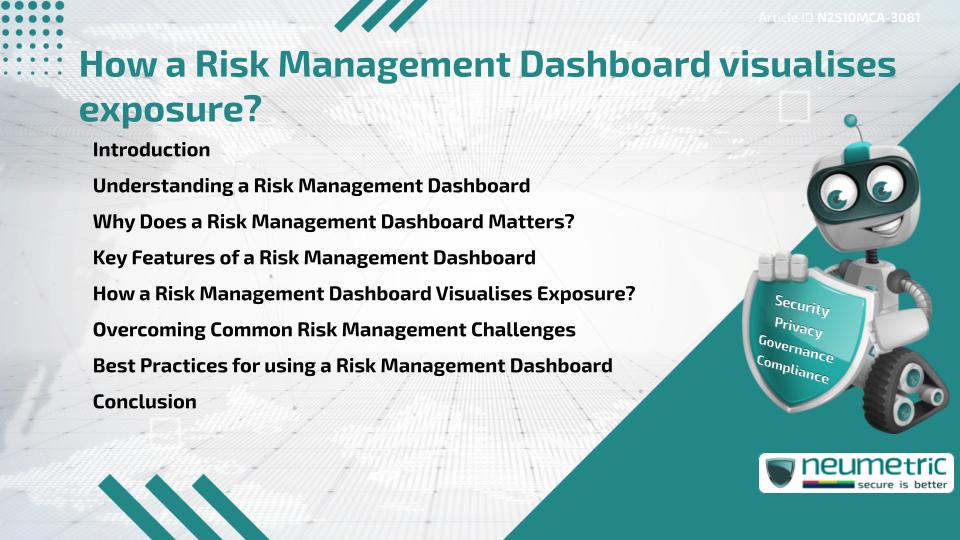Table of Contents
ToggleIntroduction
A Risk Management Dashboard helps organisations understand & control their exposure to Risk by transforming complex Data into clear, actionable Insights. It consolidates Information from multiple Sources into visual Reports, allowing teams to prioritise Threats, monitor Key indicators & make informed decisions quickly. By centralising Risk visibility, a Risk Management Dashboard supports proactive management & stronger organisational resilience.
Understanding a Risk Management Dashboard
A Risk Management Dashboard is a digital tool that aggregates & displays Risk-related Data in real time. It provides a clear overview of Threats, Vulnerabilities & mitigation efforts across different departments or projects.
This Dashboard typically integrates with Governance, Compliance & Incident Systems to collect Data automatically. Risks are then categorised, scored & visualised through Charts & Key Risk Indicators [KRIs], making it easier for leadership to understand exposure levels & emerging trends.
Why Does a Risk Management Dashboard Matters?
Managing Risks manually can result in Information silos & delayed decisions. A Risk Management Dashboard solves this by offering:
- Centralised visibility into all organisational Risks.
- Real-time tracking of Risk trends & changes.
- Data-driven insights for faster Decision-making.
- Improved communication between Risk & Executive teams.
With these capabilities, organisations can shift from reactive responses to proactive Risk Mitigation strategies.
Key Features of a Risk Management Dashboard
An effective Risk Management Dashboard typically includes:
- Risk Heat Maps – Visualise Risk Severity & Likelihood at a glance.
- Key Risk Indicators [KRIs] – Monitor metrics that signal Potential Threats.
- Trend Analysis – Track Risk evolution over time.
- Automated Alerts – Notify teams of changes in Risk levels.
- Customisable Reports – Generate summaries for Executives & Auditors.
These features help organisations understand where their biggest Vulnerabilities lie & how they can reduce overall exposure efficiently.
How a Risk Management Dashboard Visualises Exposure?
A Risk Management Dashboard translates raw Data into meaningful visuals that highlight High Risk areas. For example, a Heat map may show Financial Risks in Red, Operational Risks in Orange & Low-severity Risks in Green, helping Managers prioritise Remediation efforts instantly.
By correlating Data from Multiple Systems, the Dashboard provides a complete picture of exposure, covering Compliance gaps, security Threats & Business Process Risks. This visibility allows leaders to allocate resources where they are needed most.
Overcoming Common Risk Management Challenges
Traditional reporting methods often fail to keep up with fast-changing Risk Environments. A Risk Management Dashboard overcomes these challenges by:
- Automating Data collection from Multiple Systems.
- Eliminating manual reporting delays.
- Providing real-time insights instead of Static Summaries.
- Supporting predictive Analytics to anticipate future Risks.
This automation ensures decisions are based on accurate, current Information rather than outdated Reports.
Best Practices for using a Risk Management Dashboard
To maximise the benefits of a Risk Management Dashboard:
- Define Risk Categories & Metrics clearly.
- Integrate it with Compliance & Incident Management Tools.
- Review KRIs regularly to ensure accuracy.
- Train users to interpret Data & Respond quickly.
- Conduct Quarterly reviews to adjust Thresholds & Priorities.
Following these practices ensures the Dashboard remains aligned with organisational goals & Risk appetite.
Conclusion
A Risk Management Dashboard transforms how organisations understand & control Risk exposure. By providing Real-time Visualisation, Automation & Data-driven insights, it empowers leaders to detect emerging Threats, prioritise responses & build long-term resilience.
Takeaways
- A Risk Management Dashboard Centralises & Visualises Risk Data.
- Heat Maps & KRIs reveal exposure levels clearly.
- Automation ensures timely, accurate reporting.
- Continuous Monitoring supports proactive Decision-making.
FAQ
What is a Risk Management Dashboard?
It is a Digital Platform that visualises & monitors organisational Risks in real time.
How does it Visualise exposure?
Through Charts, Heat Maps & Risk indicators that highlight High Risk areas.
Who uses it?
Risk managers, Compliance teams, Executives & Auditors.
Can it integrate with other Tools?
Yes, it connects with Governance, Compliance & Incident Systems.
What are its main benefits?
Real-time insights, prioritised Risk response & improved Decision-making.
References
- ISO.org – Risk Management Standards
- NIST – Risk Management Framework
- ENISA – Enterprise Risk Visualisation Guidelines
- SANS Institute – Risk Dashboard Design Principles
- CISA – Risk Monitoring & Reporting Best Practices
Need help for Security, Privacy, Governance & VAPT?
Neumetric provides organisations the necessary help to achieve their Cybersecurity, Compliance, Governance, Privacy, Certifications & Pentesting needs.
Organisations & Businesses, specifically those which provide SaaS & AI Solutions in the Fintech, BFSI & other regulated sectors, usually need a Cybersecurity Partner for meeting & maintaining the ongoing Security & Privacy needs & requirements of their Enterprise Clients & Privacy conscious Customers.
SOC 2, ISO 27001, ISO 42001, NIST, HIPAA, HECVAT, EU GDPR are some of the Frameworks that are served by Fusion – a SaaS, multimodular, multitenant, centralised, automated, Cybersecurity & Compliance Management System.
Neumetric also provides Expert Services for technical security which covers VAPT for Web Applications, APIs, iOS & Android Mobile Apps, Security Testing for AWS & other Cloud Environments & Cloud Infrastructure & other similar scopes.
Reach out to us by Email or filling out the Contact Form…


